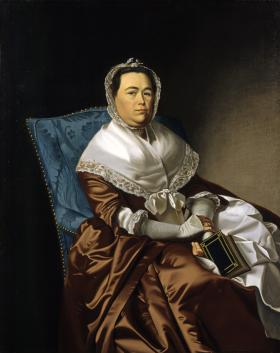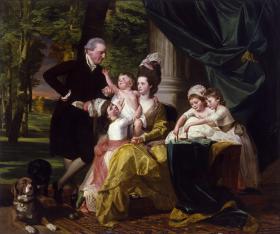1. Assign the class to examine Mrs. James Russell (Katherine Graves) and Sir William Pepperrell and His Family. Students should list on the board some characteristics of Mrs. James Russell and Elizabeth Royall (Lady Pepperrell) based on evidence in the paintings. Encourage students to read the paintings for themselves. Examples of characteristics and biographical details are:
- Mrs. James Russell: dignified, affluent, educated, daughter of a puritan, wife of a magistrate, mother of 11
- Elizabeth Royall: attractive, aristocratic, blessed with a great fortune, mother of a male heir
2. Ask the students to think about the terms on the board as they examine the paintings. Assign students to watch John Coffey’s lecture or read the background information on these works of art. Within a class discussion, use the following questions to examine how the women’s portraits reveal their respective Patriot and Loyalist ideals:
- What is each woman wearing?
- What is each woman doing?
- What do her clothing and her activity tell you about this woman?
3. Assign students to examine the lyrics to the “Address to the Ladies” written by John Renfro Davis in 1769. Within another (shorter) class discussion, use the following questions to develop students’ understanding of the values associated with apparel during the Revolutionary era.
- According the songwriter, what kinds of clothes should good Patriot women be wearing?
- What shouldn’t they wear? Why?
- Do the outfits of Mrs. James Russell and Lady Pepperrell reflect the values expressed in the lyrics? Why or why not? Is there a difference between the clothing of the two women?
4. Assign students to read the Chronicle of the Revolution about the Boston Tea Party and the excerpt on Boston in 1775. Using that description, their knowledge of the revolutionary era in Boston, the information they have gathered from Davis’s lyrics and their analysis of the portraits of the two women, assign the students to consider how each of these women would have reacted to the Boston Tea Party in November 1773. Assign students to write a diary entry (one paragraph for each woman) that responds to this event from the point of view of each of these women.
5. Artists add specific details or features to the portraits they paint to signify information about their subjects and the world in which they live. Assign students to consider the following questions to prepare for homework.
- What is the setting of each painting?
- Why might the artist have selected those settings for this person?
- How does the artist’s choice of specific details (the activities of the subjects and their settings) inform the viewer’s perceptions about these women?
Assign students to imagine themselves as artists working on a self-portrait. Assign students to write a paragraph describing the setting, clothing, and props they would include in their self-portraits to guide their viewers to a specific perception about themselves and the times in which they live.
- Active participation in group discussions will demonstrate students’ ability to:
- Analyze works of art through careful deconstruction of the images and composition.
- Evaluate the history, society, politics, and economics of the Revolutionary era by examining contemporary works of art.
- Interpret art through the historical context of the paintings’ subjects.
- Analyze and integrate information from visual, literary, and musical sources.
- Clearly written, effectively and correctly detailed diary entries will demonstrate students’ comprehension of the issues and the multiple perspectives of various peoples of the past, as well as their ability to support interpretations with historical evidence.
- Thoughtful and detailed paragraphs on elements that students would include in their own portraits will demonstrate students’ ability to interpret visual arts from a personal, cultural, and historical context.
- Students will understand the role of art in documenting historical events, specifically as a means to understand the culture of the United States in historical context.
attribute
affluent
Puritan
magistrate
aristocratic
Loyalist
perception
Learn More, Teach More lecture by John Coffey
Chronicle of the Revolution, “High Tea in Boston Harbor” (Liberty Series, PBS)
“Boston, 1775” (Loyalist perspectives) National Postal Museum
Songs of the Revolution—Song 9. “Address to the Ladies” by John Renfro Davis (1769) Carpenter’s Hall Web site
COPLEY AND THE FACE OF COLONIAL AMERICA
One way to look at a portrait is as a conspiracy; the artist and the sitter have entered into a plot against us, the viewers. Together, they present us with a fiction, some of it perhaps true, other aspects wishful. Copley's portrait of Katherine Graves, wife of Judge James Russell of Charlestown, Massachusetts, is one example of this type of artistic conspiracy.
What do we know about this woman? Or rather what do she and the artist want us to know? We know she is affluent. Her clothing is expensive, but not ostentatious - just what one would expect of a wealthy daughter of Puritans. The book in her hand tells us the woman is educated and has the leisure time to read - an important distinction at a time when most women were illiterate and endured lives of grueling labor.
All the clues add up to a picture of a woman of property and gentility, a matriarch of a proud family. But Copley adds something more to this image. He endows this woman with a strong physical presence. His artistry - above all the play of light and shadow that sculpts the figure and pushes her forward into our space - gives life to Katherine Russell, daughter and wife of magistrates and mother of 11 children. However, beyond the likeness, which we assume to be accurate, we are told nothing personal about Mrs. Russell. For her, it is only important to be regarded as a member in good standing of the social and governing elite. And what better way to assert and affirm her privileged position than to be painted by the leading portrait painter in the American colonies?
In this painting we see something of the longings for high culture and social status of Americans on the eve of Independence. We often forget that upper-class families like the Russells in Massachusetts, or the Washingtons in Virginia, modeled their manners and aspirations after the English aristocracy. Right up to the Revolution, many colonial families thought of themselves socially and culturally, if not politically, as gentry in a far shire of England. The Revolution tore the social fabric of British North America. The Russells sided with the patriots and were rewarded with generations of prosperity. Other families were not so fortunate.
Click here to view a related video produced in association with the North Carolina School of Science and Math's Learn More - Teach More Project. (RealPlayer is required to view this video file.)
John Singleton Copley was never content with being the finest portrait painter in a provincial outpost of the British Empire. While building his career and fortune in Boston, he dreamed of making the voyage to Europe to study the works of the old masters and prove himself against the best of London's painters. Finally, in 1774, after years of indecision, Copley left for Europe.
After a study tour of Italy, Copley and his family settled in London, where he set about the daunting task of establishing himself as a painter of the front rank. As might be expected, a number of his earliest patrons were fellow Americans, including Sir William Pepperrell (1746–1816), who had arrived in London a year after Copley. Sir William was the grandson and heir of William Pepperrell (1696–1759), a prosperous merchant, politician, and soldier, and the first native-born American to be awarded the title of baronet. The younger Pepperrell further enhanced the family's stature by marrying the daughter of Isaac Royall, one of the wealthiest men in British America.
However, during the turbulent years leading up to the American Revolution, Pepperrell remained steadfastly loyal to the British Crown. Fearing mob violence and the wholesale confiscation of his property, he sailed from Boston with his family toward an uncertain exile. Soon after arriving in 1775, Pepperrell commissioned Copley to paint a family portrait. When finished, the painting was more than the standard, flattering celebration of a proud, illustrious family. It also symbolized with poignant irony the tragedy of the Pepperrells.
No doubt in accord with the wishes of his client, Copley staged an extravagant, yet intimate portrayal of Sir William, his wife, Elizabeth, and their three daughters and newborn son. He invented a setting that is neither a proper interior nor a landscape, but a studio fantasy. The colossal fluted column, Baroque drapery, plush "Turkey" carpet, and the inviting glimpse of a twilight park were stock devices in royal and aristocratic portraiture, signifying wealth, refinement and power.
Unfortunately, the portrait is an elaborate fiction, designed by client and artist to mask an unacceptable reality. The Pepperrells were not English upper class, but American exiles who had lost much of their fortune. Moreover, Elizabeth Royall Pepperrell had died in Boston two years before the portrait was painted. (For her likeness, Copley probably relied upon a portrait miniature.) For the widower and his children, Copley offered a comforting vision of what might have been, had not war and death come knocking.



